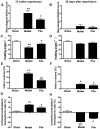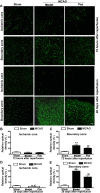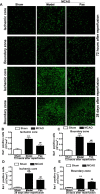Protective effects of paeonol on subacute/chronic brain injury during cerebral ischemia in rats
- PMID: 29563983
- PMCID: PMC5858057
- DOI: 10.3892/etm.2018.5893
Protective effects of paeonol on subacute/chronic brain injury during cerebral ischemia in rats
Abstract
Ischemic stroke is a highly complex pathological process that is divided into acute, subacute and chronic phases. Paeonol is a biologically active natural product with a variety of pharmacological effects, including those on neuronal activity. However, the effects of paeonol on subacute/chronic ischemic stroke have remained to be elucidated. The present study was designed to investigate the effects of paeonol against subacute and chronic cerebral ischemic injury and to explore the possible underlying mechanisms. Male adult Sprague Dawley rats were randomly divided into a sham group (treated with saline), a model group [subjected to middle cerebral artery occlusion (MCAO) and treated with saline] and a paeonol-treated group (MCAO + paeonol at 25 mg/kg). Behavioral impairment, infarct volume and ischemic/contralateral hemispheric ratios were assessed at 72 h and at 28 days after MCAO, respectively. Immunofluorescence was employed to determine the neuronal damage and glial responses after MCAO. Compared with the model group, paeonol treatment significantly attenuated behavioral impairment, ischemic infarct volume and moderate cerebral edema in the ischemic brain at 72 h, as well as brain atrophy at 28 days after reperfusion. Furthermore, paeonol treatment ameliorated neuronal damage in the ischemic core and boundary zone regions at 72 h after reperfusion and in the boundary zone at 28 days after reperfusion. In addition, paeonol treatment reduced the proliferation of astrocytes in the boundary zone, and inhibited microglial activation in the ischemic core and boundary zone regions at 72 h and 28 days after reperfusion. These results demonstrated the protective effects of paeonol against subacute/chronic cerebral ischemia, and the mechanism of action may include subacute/chronic microglial activation and astrocyte proliferation.
Keywords: cerebral ischemia; paeonol; rat; subacute/chronic brain injury.
Figures





Similar articles
-
Increased expression of cysteinyl leukotriene receptor-1 in the brain mediates neuronal damage and astrogliosis after focal cerebral ischemia in rats.Neuroscience. 2006 Jul 7;140(3):969-79. doi: 10.1016/j.neuroscience.2006.02.051. Epub 2006 May 2. Neuroscience. 2006. PMID: 16650938
-
HAMI 3379, a CysLT2R antagonist, dose- and time-dependently attenuates brain injury and inhibits microglial inflammation after focal cerebral ischemia in rats.Neuroscience. 2015 Apr 16;291:53-69. doi: 10.1016/j.neuroscience.2015.02.002. Epub 2015 Feb 11. Neuroscience. 2015. PMID: 25681271
-
Breviscapine confers a neuroprotective efficacy against transient focal cerebral ischemia by attenuating neuronal and astrocytic autophagy in the penumbra.Biomed Pharmacother. 2017 Jun;90:69-76. doi: 10.1016/j.biopha.2017.03.039. Epub 2017 Mar 24. Biomed Pharmacother. 2017. PMID: 28343073
-
Temporal profile of nestin expression after focal cerebral ischemia in adult rat.Brain Res. 1999 Aug 14;838(1-2):1-10. doi: 10.1016/s0006-8993(99)01502-4. Brain Res. 1999. PMID: 10446310
-
Proteomic Analysis of Rat Cerebral Cortex in the Subacute to Long-Term Phases of Focal Cerebral Ischemia-Reperfusion Injury.J Proteome Res. 2019 Aug 2;18(8):3099-3118. doi: 10.1021/acs.jproteome.9b00220. Epub 2019 Jul 2. J Proteome Res. 2019. PMID: 31265301
Cited by
-
Paeonol Protection Against Intrastriatal 6-Hydroxydopamine Rat Model of Parkinson's Disease.Basic Clin Neurosci. 2021 Jan-Feb;12(1):43-56. doi: 10.32598/bcn.12.6.88.7. Epub 2021 Jan 1. Basic Clin Neurosci. 2021. PMID: 33995926 Free PMC article.
-
Quantitative proteomics revealed extensive microenvironmental changes after stem cell transplantation in ischemic stroke.Front Med. 2022 Jun;16(3):429-441. doi: 10.1007/s11684-021-0842-9. Epub 2021 Jul 9. Front Med. 2022. PMID: 34241786
-
Synthesis of Paeonol-Ozagrel Conjugate: Structure Characterization and In Vivo Anti-Ischemic Stroke potential.Front Pharmacol. 2021 Feb 1;11:608221. doi: 10.3389/fphar.2020.608221. eCollection 2020. Front Pharmacol. 2021. PMID: 33597878 Free PMC article.
-
Paeonol Induces Protective Autophagy in Retinal Photoreceptor Cells.Front Pharmacol. 2021 May 26;12:667959. doi: 10.3389/fphar.2021.667959. eCollection 2021. Front Pharmacol. 2021. PMID: 34122088 Free PMC article.
-
Paeonol Ameliorates Cognitive Deficits in Streptozotocin Murine Model of Sporadic Alzheimer's Disease via Attenuation of Oxidative Stress, Inflammation, and Mitochondrial Dysfunction.J Mol Neurosci. 2022 Feb;72(2):336-348. doi: 10.1007/s12031-021-01936-1. Epub 2021 Nov 19. J Mol Neurosci. 2022. PMID: 34797511
References
-
- Jauch EC, Saver JL, Adams HP, Jr, Bruno A, Connors JJ, Demaerschalk BM, Khatri P, McMullan PW, Jr, Qureshi AI, Rosenfield K, et al. Guidelines for the early management of patients with acute ischemic stroke: A guideline for healthcare professionals from the American Heart Association/American Stroke Association. Stroke. 2013;44:870–947. doi: 10.1161/STR.0b013e318284056a. - DOI - PubMed
LinkOut - more resources
Full Text Sources
Other Literature Sources
